Are Hairless Guinea Pigs Good Pets? Absolutely. These unique cavies, also known as skinny pigs, offer a delightful and engaging experience for pet lovers. At PETS.EDU.VN, we delve into the specifics of caring for these special companions, ensuring they thrive in your home. Discover everything about skinny pig ownership, including their needs and health.
1. Unveiling the World of Hairless Guinea Pigs
Hairless guinea pigs, often called skinny pigs, are a captivating and unique breed. Their lack of fur sets them apart from their more common, fluffy relatives, raising questions about their origin, care requirements, and suitability as pets.
Alt Text: A group of happy, hairless guinea pigs enjoy a snack of hay in their comfortable, fleece-lined enclosure.
1.1. The History and Origin of Skinny Pigs
The journey of the hairless guinea pig began unexpectedly in a Canadian lab in 1978, stemming from an accidental genetic mutation. Initially, their unique trait made them valuable for dermatological testing, due to the similarity of their skin to human skin. Fortunately, today, these animals are cherished as pets worldwide. PETS.EDU.VN champions ethical treatment and breeding of all animals.
1.2. Two Distinct Hairless Breeds: Skinny Pigs vs. Baldwin Guinea Pigs
While both are hairless, skinny pigs and Baldwin guinea pigs have key differences:
| Feature | Skinny Pig | Baldwin Guinea Pig |
|---|---|---|
| Hair at Birth | Born mostly hairless, with some fuzz on the nose, feet, and legs. | Born with a full coat of fur that sheds completely within the first few months. |
| Adult Appearance | Mostly hairless body with some hair on the feet and nose. | Entirely hairless from head to toe. |
| Genetic Mutation | Spontaneous mutation | Spontaneous mutation observed in White Crested guinea pigs. |
| Popularity as Pets | Widely popular and commonly recognized as the “hairless guinea pig.” | Less common than skinny pigs but equally charming for those seeking a unique pet. |
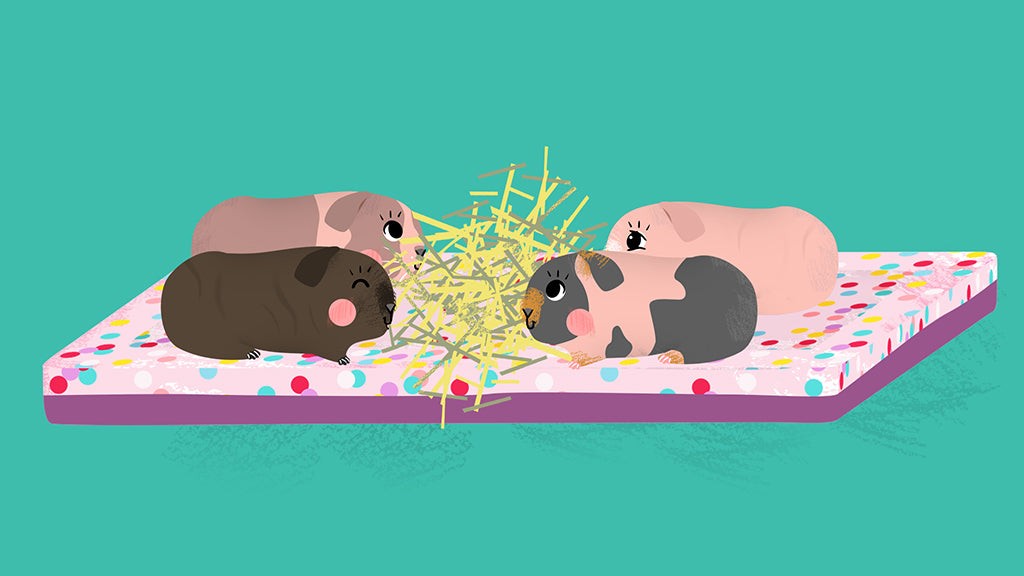

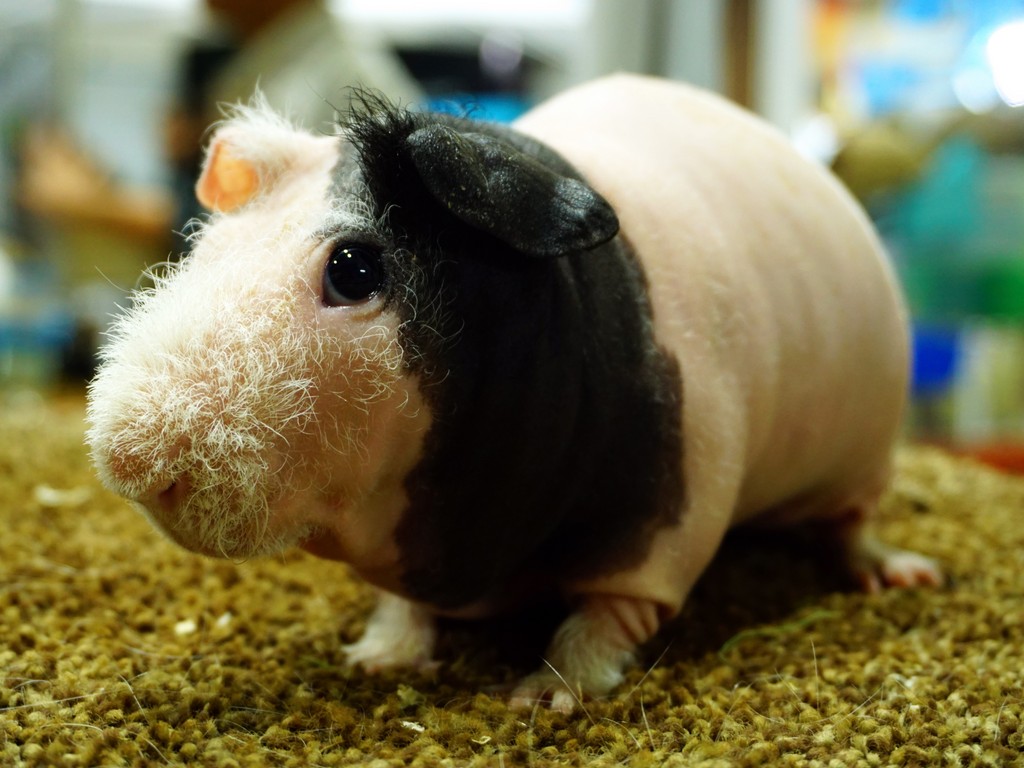
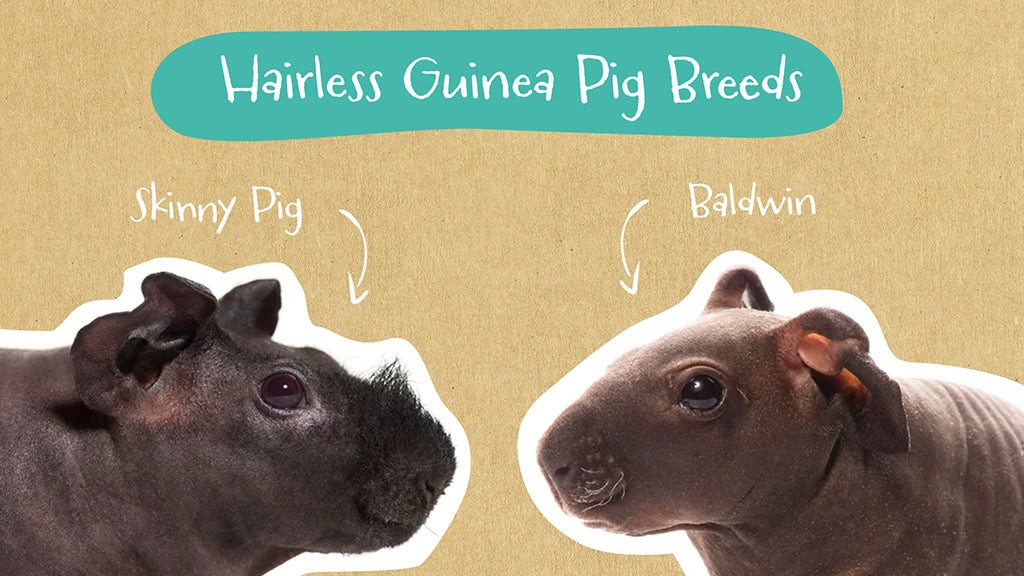

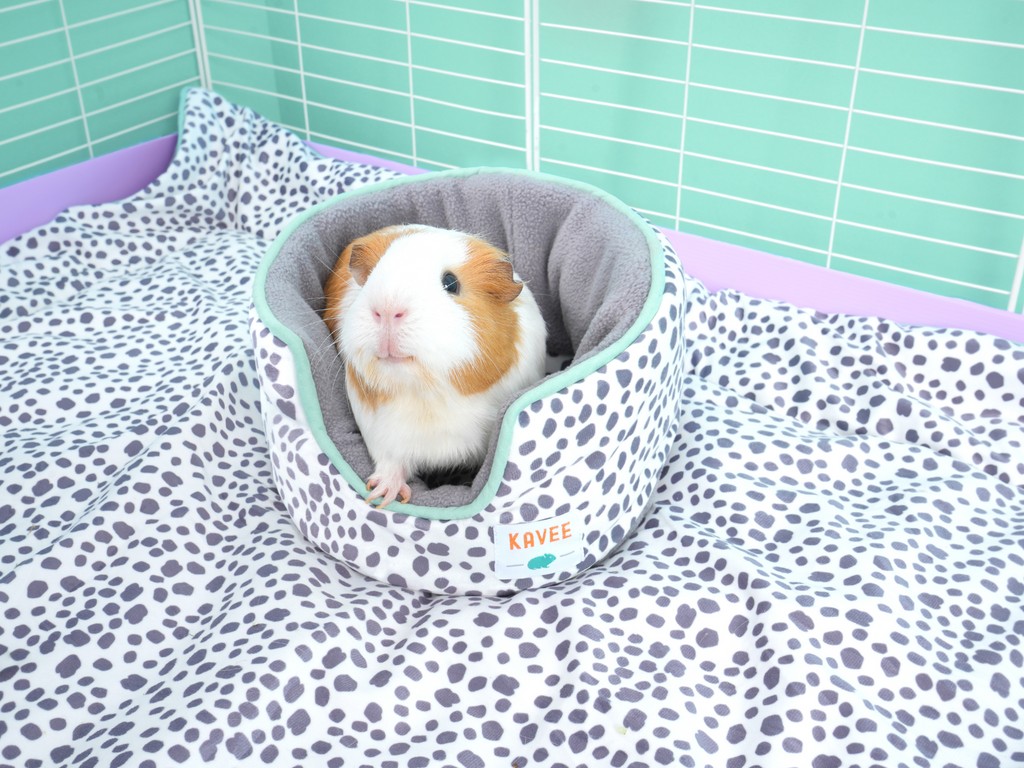
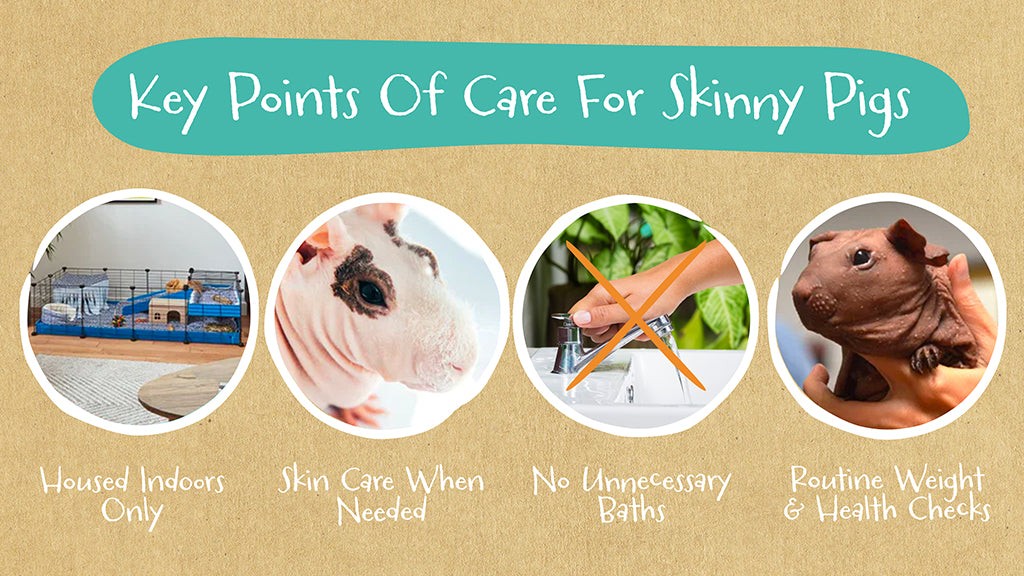
1.3. Dispelling Myths: Are Hairless Guinea Pigs Hypoallergenic?
Despite their lack of fur, skinny pigs are not hypoallergenic. Allergies are primarily triggered by dander (dead skin cells), which all guinea pigs produce, regardless of hair length. If you have allergies, spending time with a skinny pig before bringing one home is essential to assess your reaction.
2. Are Hairless Guinea Pigs Good Pets? The Unique Needs of Hairless Guinea Pigs
While sharing many similarities with their furry counterparts, hairless guinea pigs have distinct requirements that potential owners must consider.
2.1. Temperature Sensitivity: Keeping Your Skinny Pig Warm
Without fur, skinny pigs are more susceptible to temperature changes. Maintain a consistent indoor temperature between 72°F to 75°F (21°C to 24°C) to ensure their comfort. Avoid placing their cage in drafty areas or direct sunlight.
2.2. Diet and Metabolism: Feeding a Hairless Guinea Pig
Skinny pigs have a higher metabolism than furry guinea pigs, requiring more food to maintain their body temperature. A balanced diet consisting of:
- High-quality guinea pig pellets
- Unlimited fresh hay (Timothy hay is ideal)
- A daily serving of fresh vegetables (leafy greens, bell peppers, and carrots are great choices)
Ensure constant access to fresh, clean water.
2.3. Skin Care: Protecting Their Delicate Skin
Hairless guinea pigs are prone to sunburn, dryness, and skin injuries. Proper care is crucial.
- Sun Protection: Avoid direct sunlight exposure. Provide plenty of shade if they spend time outdoors.
- Moisturizing: Apply a thin layer of coconut oil to their skin to combat dryness. Avoid the face and inner ears.
- Bathing: Bathe them only when necessary, using a mild, pet-safe shampoo. Dry them thoroughly afterward to prevent chills.
Alt Text: Two hairless guinea pigs snuggle happily inside their cozy cage, complete with a soft fleece liner.
2.4. Choosing the Right Bedding and Cage Environment
The ideal cage for a skinny pig should be:
- Spacious: Guinea pigs need ample room to move around and exercise.
- Safe: Avoid wire-bottom cages, which can injure their feet.
- Comfortable: Soft bedding like fleece liners is ideal for their sensitive skin.
2.5. Social Needs: Companionship is Key
Guinea pigs are social animals and thrive in pairs or small groups. Never keep a skinny pig alone.
3. Are Hairless Guinea Pigs Good Pets? Health and Well-being
Skinny pigs are prone to specific health issues due to their lack of fur. Regular check-ups and attentive care are crucial.
3.1. Common Health Concerns in Hairless Guinea Pigs
| Health Issue | Description | Prevention/Management |
|---|---|---|
| Skin Infections | Their exposed skin is susceptible to bacterial and fungal infections. | Keep their environment clean and dry. Regularly inspect their skin for any signs of redness, swelling, or discharge. |
| Respiratory Infections | Sensitive to drafts and temperature fluctuations, making them prone to upper respiratory infections (URIs). | Maintain a warm, draft-free environment. Monitor for symptoms like sneezing, coughing, or labored breathing. |
| Sunburn | Their lack of fur makes them highly vulnerable to sunburn. | Avoid direct sunlight exposure. Provide shade and consider using pet-safe sunscreen on exposed areas (consult a vet first). |
| Injuries | Their delicate skin is easily injured by rough surfaces or sharp objects. | Use soft bedding and ensure their environment is free from hazards. |
| Dental Issues | Like all guinea pigs, skinny pigs are prone to dental problems if their diet lacks sufficient fiber. | Provide unlimited hay to promote proper tooth wear. |
3.2. Recognizing Signs of Illness
Be vigilant in observing your skinny pig for any changes in behavior, appetite, or appearance. Common signs of illness include:
- Lethargy
- Loss of appetite
- Sneezing or coughing
- Diarrhea
- Skin lesions
- Weight loss
Consult a veterinarian experienced with guinea pigs immediately if you notice any of these signs.
3.3. The Importance of Regular Veterinary Check-ups
Annual check-ups with a qualified veterinarian are vital for maintaining your skinny pig’s health. The vet can detect and address potential health problems early on.
4. Are Hairless Guinea Pigs Good Pets? Behavior and Temperament
Skinny pigs are known for their friendly and affectionate personalities, making them wonderful companions.
4.1. Socializing with Your Hairless Guinea Pig
Spend time handling your skinny pig to build trust and strengthen your bond. Offer treats and speak to them in a gentle voice.
4.2. Understanding Guinea Pig Communication
Guinea pigs communicate through a variety of sounds, including:
- Wheeking: A loud, high-pitched squeal indicating excitement or anticipation of food.
- Rumbling: A low, guttural sound often made by males during courtship.
- Chutting: A soft, repetitive sound indicating contentment.
- Chattering: A rapid, teeth-chattering sound indicating annoyance or aggression.
4.3. Creating a Stimulating Environment
Provide your skinny pig with toys and enrichment items to keep them mentally stimulated.
- Tunnels
- Cardboard boxes
- Chew toys
Rotate toys regularly to prevent boredom.
Alt Text: A curious skinny guinea pig explores its surroundings on a soft carpet.
5. Are Hairless Guinea Pigs Good Pets? Ethical Considerations
The increasing popularity of hairless guinea pigs raises ethical concerns regarding responsible breeding and animal welfare.
5.1. Supporting Responsible Breeders
If you choose to acquire a skinny pig, research breeders thoroughly to ensure they prioritize the health and well-being of their animals.
5.2. Considering Adoption
Adopting a skinny pig from a rescue organization is an excellent way to provide a loving home for an animal in need.
5.3. Prioritizing Welfare Over Appearance
Remember that a pet’s health and well-being should always be the top priority. Be prepared to provide the specialized care that hairless guinea pigs require.
6. Are Hairless Guinea Pigs Good Pets? Practical Tips for Skinny Pig Owners
6.1. Creating a Budget for Skinny Pig Care
Owning a hairless guinea pig involves ongoing costs.
| Expense | Estimated Cost (Monthly) | Notes |
|---|---|---|
| Food (Pellets, Hay, Veggies) | $20 – $40 | Varies depending on the quality of food and the number of guinea pigs. |
| Bedding (Fleece Liners) | $15 – $30 | Fleece liners are reusable but require regular washing. |
| Veterinary Care | $10 – $50 | Includes routine check-ups and potential unexpected medical expenses. |
| Toys and Enrichment | $5 – $15 | Rotate toys regularly to keep your guinea pig engaged. |
| Coconut Oil/Skin Care | $5 – $10 | Needed to maintain healthy skin. |
6.2. Finding a Guinea Pig-Savvy Veterinarian
Not all veterinarians are experienced with guinea pigs. Seek out a vet specializing in exotic animals or small mammals.
6.3. Joining Online Communities
Connect with other skinny pig owners online to share tips, ask questions, and find support.
7. Are Hairless Guinea Pigs Good Pets? The Joy of Owning a Hairless Guinea Pig
Despite their specialized needs, hairless guinea pigs bring immense joy and companionship to their owners.
7.1. Affectionate and Engaging Pets
Skinny pigs are known for their playful and affectionate personalities.
7.2. Unique and Fascinating
Their unique appearance and behaviors make them a constant source of fascination.
7.3. Rewarding Companions
The effort you put into caring for a skinny pig is rewarded with a loving and devoted companion.
Alt Text: A side-by-side comparison of the two hairless guinea pig breeds: the skinny pig and the Baldwin guinea pig.
8. Are Hairless Guinea Pigs Good Pets? Creating the Perfect Habitat for Your Skinny Pig
8.1 Cage Size and Setup
- Minimum Cage Size: At least 7.5 square feet for two guinea pigs, but bigger is always better.
- Solid Bottom: Essential to protect their sensitive feet.
- Proper Ventilation: Avoid cages that are too enclosed, as this can lead to respiratory issues.
8.2 Bedding Options
- Fleece Liners: Soft, absorbent, and washable, making them a great eco-friendly choice.
- Paper-Based Bedding: A good alternative, but make sure it’s dust-free to prevent respiratory problems.
- Avoid: Cedar and pine shavings, as they contain oils that can be harmful to guinea pigs.
8.3 Enrichment and Toys
- Hidey Houses: Provide a sense of security and a place to escape.
- Tunnels: Guinea pigs love to explore and play in tunnels.
- Chew Toys: Essential for dental health and to prevent boredom.
- Food Puzzles: Encourage mental stimulation and foraging behavior.
8.4 Temperature Control
- Ideal Temperature: 65-75°F (18-24°C)
- Avoid Drafts: Keep the cage away from windows and doorways.
- Heating Pad (Optional): In colder climates, a pet-safe heating pad can provide extra warmth.
9. Are Hairless Guinea Pigs Good Pets? Grooming and Hygiene
9.1 Skin Care Routine
- Coconut Oil: Apply a thin layer to keep their skin moisturized, especially during dry months.
- Sunscreen: Use a pet-safe sunscreen if they’re exposed to direct sunlight, but avoid getting it in their eyes or mouth.
9.2 Bathing
- Frequency: Only when necessary, as excessive bathing can dry out their skin.
- Shampoo: Use a mild, fragrance-free pet shampoo.
- Technique: Gently lather and rinse thoroughly, avoiding the head and ears.
- Drying: Pat them dry with a soft towel and keep them warm until they’re completely dry.
9.3 Nail Trimming
- Frequency: Every 2-3 weeks, or as needed.
- Tools: Use guinea pig nail clippers.
- Technique: Trim only the tips of the nails to avoid cutting the quick (the pink part containing blood vessels).
- If You Cut the Quick: Apply styptic powder to stop the bleeding.
9.4 Ear Cleaning
- Frequency: As needed, if you notice wax buildup.
- Tools: Use a cotton ball dampened with warm water or a pet-safe ear cleaning solution.
- Technique: Gently wipe the outer ear, being careful not to insert anything into the ear canal.
10. Are Hairless Guinea Pigs Good Pets? Feeding and Nutrition
10.1 Hay
- Type: Timothy hay is the best choice, as it’s high in fiber and helps wear down their teeth.
- Availability: Should be available at all times.
10.2 Pellets
- Type: High-quality guinea pig pellets formulated with vitamin C.
- Amount: Follow the feeding guidelines on the package.
- Freshness: Store pellets in an airtight container to maintain freshness.
10.3 Fresh Vegetables
- Variety: Offer a variety of leafy greens, bell peppers, carrots, and other guinea pig-safe vegetables.
- Amount: About one cup per guinea pig per day.
- Vitamin C: Important to provide vegetables rich in vitamin C.
10.4 Water
- Source: Fresh, clean water should be available at all times in a water bottle or bowl.
- Daily Changes: Change the water daily to prevent bacteria growth.
10.5 Treats
- Options: Offer small amounts of guinea pig-safe fruits or vegetables as treats.
- Avoid: Sugary treats, nuts, and seeds, as these are unhealthy for guinea pigs.
10.6 Toxic Foods
- Avoid: Chocolate, onions, garlic, avocado, potatoes, rhubarb, and other foods that are toxic to guinea pigs.
Alt Text: A content Baldwin guinea pig enjoys a tasty apple slice.
11. Are Hairless Guinea Pigs Good Pets? Socialization and Handling
11.1 Bonding with Your Guinea Pig
- Start Slow: Let your guinea pig adjust to its new environment before attempting to handle it.
- Positive Reinforcement: Use treats and gentle words to create positive associations with handling.
- Patience: It may take time for your guinea pig to become comfortable with being handled.
11.2 Handling Techniques
- Support: Always support their body with both hands when picking them up.
- Gentle: Avoid squeezing or holding them too tightly.
- Low to the Ground: Hold them close to the ground to prevent injury if they jump.
11.3 Social Interaction
- Pair Housing: Guinea pigs are social animals and thrive in pairs or small groups.
- Supervision: Supervise interactions between guinea pigs to prevent fighting.
- Individual Attention: Spend time interacting with each guinea pig individually.
11.4 Recognizing Stress Signals
- Freezing: Remaining still and tense.
- Hiding: Seeking refuge in a hidey house or corner.
- Teeth Chattering: A sign of aggression or fear.
- Urinating/Defecating: When handled.
11.5 Training
- Litter Training: Can be trained to use a litter box.
- Trick Training: Can be taught simple tricks like coming when called or spinning.
12. Are Hairless Guinea Pigs Good Pets? Health Issues Specific to Hairless Guinea Pigs
12.1 Skin Problems
- Dry Skin: Can be treated with coconut oil.
- Sunburn: Avoid direct sunlight exposure and use pet-safe sunscreen.
- Fungal Infections: Common due to their exposed skin.
12.2 Respiratory Infections
- Sensitivity to Drafts: Keep them in a warm, draft-free environment.
- Symptoms: Sneezing, coughing, difficulty breathing.
- Treatment: Veterinary care is necessary.
12.3 Eye Problems
- Dry Eyes: Can occur due to lack of eyelashes.
- Irritation: Due to dust or debris.
- Treatment: Veterinary care may be necessary.
13. Are Hairless Guinea Pigs Good Pets? Breeding Hairless Guinea Pigs
13.1 Ethical Considerations
- Genetic Issues: Hairlessness is a recessive trait, and breeding can lead to health problems if not done responsibly.
- Overpopulation: Responsible breeding practices are important to prevent overpopulation of guinea pigs.
13.2 Breeding Practices
- Health Screening: Before breeding, both guinea pigs should be screened for health problems.
- Genetic Diversity: Maintain genetic diversity to prevent health issues.
- Proper Housing: Provide a safe and comfortable environment for pregnant guinea pigs and their babies.
13.3 Pregnancy and Care of Newborns
- Gestation Period: About 59-72 days.
- Litter Size: Typically 1-8 pups.
- Newborn Care: The mother will care for the pups, but it’s important to provide a safe and clean environment.
- Weaning: Pups are typically weaned at 3 weeks old.
14. Are Hairless Guinea Pigs Good Pets? Legal and Ethical Considerations
14.1 Animal Welfare Laws
- Local Laws: Be aware of local animal welfare laws and regulations.
- Responsible Ownership: Provide proper care and treatment to your guinea pigs.
14.2 Abandonment
- Never Abandon: It is illegal and unethical to abandon a pet.
- Rehoming: If you can no longer care for your guinea pig, find a responsible new home or surrender it to a rescue organization.
15. Are Hairless Guinea Pigs Good Pets? Resources and Support
15.1 Veterinarians
- Exotic Animal Vets: Find a veterinarian experienced with guinea pigs.
- Emergency Care: Know the location of the nearest emergency veterinary clinic.
15.2 Rescue Organizations
- Local Rescues: Contact local guinea pig rescue organizations for adoption.
- National Organizations: Organizations like the Guinea Pig Welfare offer information and support.
15.3 Online Communities
- Forums: Join online guinea pig forums to connect with other owners.
- Social Media: Follow guinea pig-related social media accounts for tips and advice.
Alt Text: A guinea pig snuggles in a cozy cuddle cup, placed on a Dalmatian-print fleece liner.
16. Are Hairless Guinea Pigs Good Pets? Conclusion: Are Hairless Guinea Pigs Right for You?
Hairless guinea pigs are unique and rewarding pets that require specialized care. By understanding their needs and providing them with proper care, you can enjoy years of companionship with these fascinating creatures. At PETS.EDU.VN, we are dedicated to providing you with the most accurate and up-to-date information to help you make informed decisions about pet ownership.
If you’re considering getting a hairless guinea pig, be sure to do your research and be prepared to provide them with the love and care they need to thrive.
17. Call to Action
Ready to learn more about hairless guinea pigs and other amazing pets? Visit PETS.EDU.VN today for a wealth of information, expert advice, and resources to help you become the best pet owner you can be. Contact us at 789 Paw Lane, Petville, CA 91234, United States. Whatsapp: +1 555-987-6543. Website: pets.edu.vn.
18. FAQ: Answering Your Questions About Hairless Guinea Pigs
18.1. What is the average lifespan of a hairless guinea pig?
Like their furry counterparts, hairless guinea pigs typically live for 5 to 7 years. Proper care can even extend their lifespan.
18.2. Do hairless guinea pigs require special housing?
Yes, they need an indoor cage with soft bedding, a constant temperature, and protection from drafts and direct sunlight.
18.3. How often should I bathe my hairless guinea pig?
Only when necessary, as excessive bathing can dry out their skin. Use a mild, pet-safe shampoo.
18.4. What should I feed my hairless guinea pig?
A balanced diet of high-quality guinea pig pellets, unlimited Timothy hay, and fresh vegetables.
18.5. Are hairless guinea pigs good with children?
With gentle handling and proper supervision, hairless guinea pigs can be wonderful pets for children.
18.6. Do hairless guinea pigs need sunscreen?
Yes, if they are exposed to direct sunlight, use a pet-safe sunscreen on exposed areas.
18.7. Can hairless guinea pigs live with furry guinea pigs?
Yes, as long as they are properly introduced and get along.
18.8. What are the signs of a healthy hairless guinea pig?
Alertness, a healthy appetite, smooth skin, and normal droppings.
18.9. Where can I adopt a hairless guinea pig?
Check with local guinea pig rescue organizations and animal shelters.
18.10. What are the ethical considerations of owning a hairless guinea pig?
Ensure that you are prepared to provide the specialized care they require and support responsible breeding practices.
Alt Text: An illustrated guide offers tips and advice on how to provide excellent care for skinny pigs.
